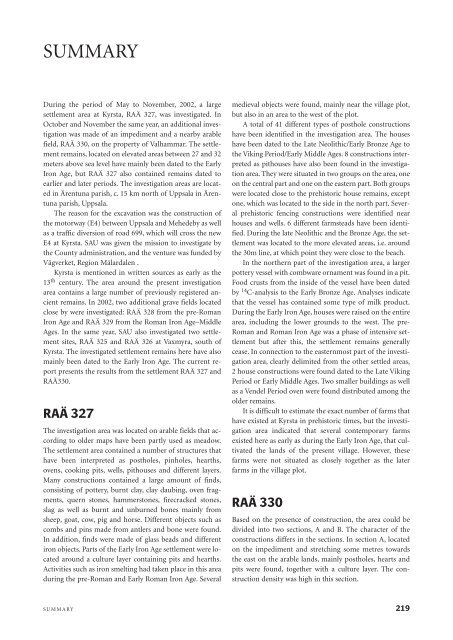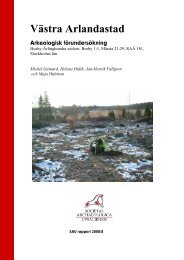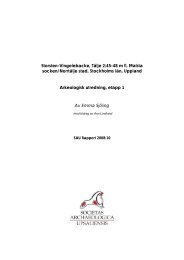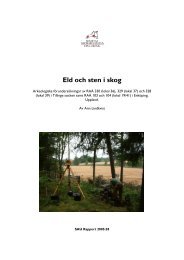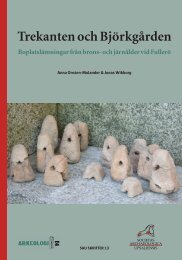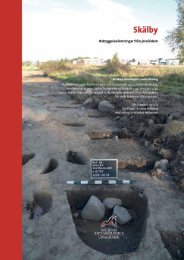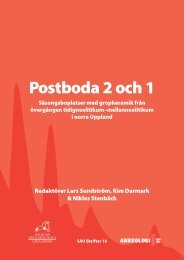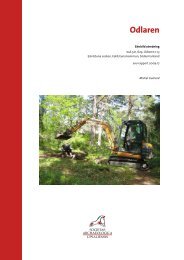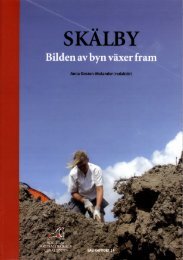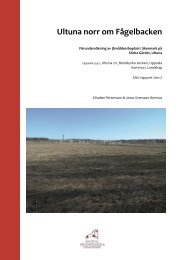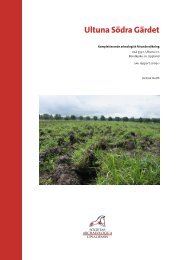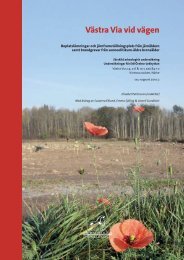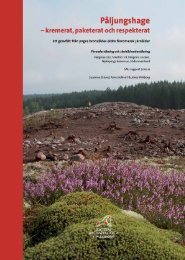You also want an ePaper? Increase the reach of your titles
YUMPU automatically turns print PDFs into web optimized ePapers that Google loves.
SUMMARY<br />
During the period of May to November, 2002, a large<br />
settlement area at Kyrsta, RAÄ 327, was investigated. In<br />
October and November the same year, an additional investigation<br />
was made of an impediment and a nearby arable<br />
field, RAÄ 330, on the property of Valhammar. The settlement<br />
remains, located on elevated areas between 27 and 32<br />
meters above sea level have mainly been dated to the Early<br />
Iron Age, but RAÄ 327 also contai<strong>ned</strong> remains dated to<br />
earlier and later periods. The investigation areas are located<br />
in Ärentuna parish, c. 15 km north of Uppsala in Ärentuna<br />
parish, Uppsala.<br />
The reason for the excavation was the construction of<br />
the motorway (E4) between Uppsala and Mehedeby as well<br />
as a traffic diversion of road 699, which will cross the new<br />
E4 at Kyrsta. <strong>SAU</strong> was given the mission to investigate by<br />
the County administration, and the venture was funded by<br />
Vägverket, Region Mälardalen .<br />
Kyrsta is mentio<strong>ned</strong> in written sources as early as the<br />
13 th century. The area around the present investigation<br />
area contains a large number of previously registered ancient<br />
remains. In 2002, two additional grave fields located<br />
close by were investigated: RAÄ 328 from the pre-Roman<br />
Iron Age and RAÄ 329 from the Roman Iron Age–Middle<br />
Ages. In the same year, <strong>SAU</strong> also investigated two settlement<br />
sites, RAÄ 325 and RAÄ 326 at Vaxmyra, south of<br />
Kyrsta. The investigated settlement remains here have also<br />
mainly been dated to the Early Iron Age. The current report<br />
presents the results from the settlement RAÄ 327 and<br />
RAÄ330.<br />
RAÄ 327<br />
The investigation area was located on arable fields that according<br />
to older maps have been partly used as meadow.<br />
The settlement area contai<strong>ned</strong> a number of structures that<br />
have been interpreted as postholes, pinholes, hearths,<br />
ovens, cooking pits, wells, pithouses and different layers.<br />
Many constructions contai<strong>ned</strong> a large amount of finds,<br />
consisting of pottery, burnt clay, clay daubing, oven fragments,<br />
quern stones, hammerstones, firecracked stones,<br />
slag as well as burnt and unbur<strong>ned</strong> bones mainly from<br />
sheep, goat, cow, pig and horse. Different objects such as<br />
combs and pins made from antlers and bone were found.<br />
In addition, finds were made of glass beads and different<br />
iron objects. Parts of the Early Iron Age settlement were located<br />
around a culture layer containing pits and hearths.<br />
Activities such as iron smelting had taken place in this area<br />
during the pre-Roman and Early Roman Iron Age. Several<br />
medieval objects were found, mainly near the village plot,<br />
but also in an area to the west of the plot.<br />
A total of 41 different types of posthole constructions<br />
have been identified in the investigation area. The houses<br />
have been dated to the Late Neolithic/Early Bronze Age to<br />
the Viking Period/Early Middle Ages. 8 constructions interpreted<br />
as pithouses have also been found in the investigation<br />
area. They were situated in two groups on the area, one<br />
on the central part and one on the eastern part. Both groups<br />
were located close to the prehistoric house remains, except<br />
one, which was located to the side in the north part. Several<br />
prehistoric fencing constructions were identified near<br />
houses and wells. 6 different farmsteads have been identified.<br />
During the late Neolithic and the Bronze Age, the settlement<br />
was located to the more elevated areas, i.e. around<br />
the 30m line, at which point they were close to the beach.<br />
In the northern part of the investigation area, a larger<br />
pottery vessel with combware ornament was found in a pit.<br />
Food crusts from the inside of the vessel have been dated<br />
by 14 C-analysis to the Early Bronze Age. Analyses indicate<br />
that the vessel has contai<strong>ned</strong> <strong>som</strong>e type of milk product.<br />
During the Early Iron Age, houses were raised on the entire<br />
area, including the lower grounds to the west. The pre-<br />
Roman and Roman Iron Age was a phase of intensive settlement<br />
but after this, the settlement remains generally<br />
cease. In connection to the easternmost part of the investigation<br />
area, clearly delimited from the other settled areas,<br />
2 house constructions were found dated to the Late Viking<br />
Period or Early Middle Ages. Two smaller buildings as well<br />
as a Vendel Period oven were found distributed among the<br />
older remains.<br />
It is difficult to estimate the exact number of farms that<br />
have existed at Kyrsta in prehistoric times, but the investigation<br />
area indicated that several contemporary farms<br />
existed here as early as during the Early Iron Age, that cultivated<br />
the lands of the present village. However, these<br />
farms were not situated as closely together as the later<br />
farms in the village plot.<br />
RAÄ 330<br />
Based on the presence of construction, the area could be<br />
divided into two sections, A and B. The character of the<br />
constructions differs in the sections. In section A, located<br />
on the impediment and stretching <strong>som</strong>e metres towards<br />
the east on the arable lands, mainly postholes, hearts and<br />
pits were found, together with a culture layer. The construction<br />
density was high in this section.<br />
SUMMARY 219


